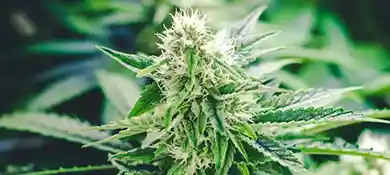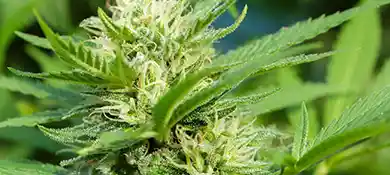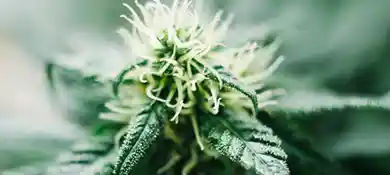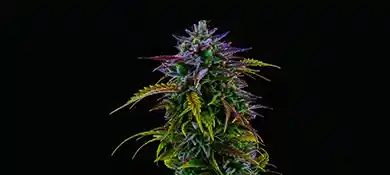Why Brown Spots on Weed Leaves Shouldn't Be Ignored
You're scanning your cannabis garden when your eyes land on a leaf with mysterious brown spots. Yep, brown spots on weed leaves—every grower's dread. It's like spotting a bad tattoo on your favorite celebrity; you can't help but wonder, "What went wrong?"
Now, you could pretend it's no big deal, like those faded jeans from the '90s that you swear will make a comeback. But let's face reality. Ignoring brown spots on your cannabis leaves is a fast track to a wild garden. Trust me, this isn't something you can solve with a Band-Aid and a wish.
So, why are we so hung up on brown spots? Because they're not just cosmetic flaws; they're warning signs. Your plant says, "Hey, something's not cool here!" Stick around as we unravel the mystery behind these troublesome spots, explore their common causes, and map out a recovery game plan for your green beauties.
Why You Should Care About Brown Spots on Weed Leaves
Brown spots on cannabis leaves should not be taken lightly; they serve as important indicators that require immediate attention. These markings are more than mere cosmetic flaws; they are the plant's method of signaling distress. Dismissing them as insignificant could ensure the overall health of your crop is maintained.
In medical terms, consider these brown spots analogous to early symptoms in a diagnosis. While they may appear benign, they could be precursors to more severe issues that could jeopardize your harvest. Unlike animals or humans, cannabis plants cannot communicate their issues directly; their leaves serve as the medium to express their needs. When brown spots appear, it's akin to an urgent message that demands prompt intervention.
Ignoring these initial warning signs could escalate into more complicated problems, such as nutrient deficiencies, diseases, or pest infestations, severely affecting your yield. A comprehensive understanding of these early indicators is integral to successful cannabis cultivation. As such, these blemishes must be properly identified and treated promptly.
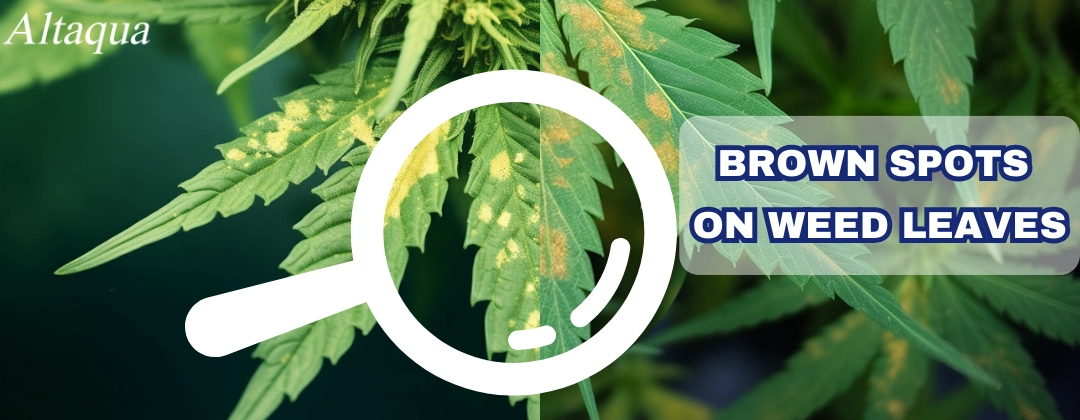
Common Causes of Brown Spots on Cannabis Leaves
Cannabis leaves work like the all-in-one kitchen appliances of the plant world. They've got multiple roles—processing sunlight, channeling nutrients, and serving as the plant's alarm system. When brown spots appear on these leaves, it's the plant's way of sending out an SOS. But before you can take action, you need to play detective. Let’s dive into the nitty-gritty of what's going on.
Nutrient Deficiencies Causing Brown Spots
Nutrients are more than just plant food; they're the foundational building blocks your cannabis plants rely on. When these go missing, you're basically asking your plants to cook a full meal with just salt and pepper—unlikely to end well.
Calcium Deficiency
Without enough calcium, your cannabis plants will stage a full-on revolt. Older leaves will feature brown spots, especially along the edges, while newer leaves might appear misshapen or die off. Apart from these brown spots, you may also notice:
- Foliage is beginning to wilt
- Sluggish flowering stages
- Leaf tips are starting to curl
- Weak or hollow stems
- Roots that are short and dry
- There is a general smallness to both leaves and buds
If your plant could talk, it would say, “Get me some calcium, ASAP!”
Nitrogen Deficiency
Nitrogen is like the energy drink of the nutrient world. It keeps the leaves green and the plant growing. But without it, older leaves will turn yellow and start showing brown spots, eventually curling up and falling off. This spells big trouble, particularly during the flowering stage when the plant needs extra nutrition. Watch out for:
- Yellowing of older leaves
- Brown or purple stems
- Leaves drooping or wilting
And let’s be clear: it’s not just the leaves. In advanced stages, the shortage hits newer leaves and branches, too.
Potassium Deficiency
When potassium gets scarce, your plant struggles in multiple areas—it's like trying to win a soccer game with no goalkeeper. Older leaves might display brown or black spots surrounded by yellow. Symptoms don't end there:
- Foliage turns pale and discolored
- Odd, stunted growth patterns
- Leaf edges curling upwards
- Thin stems and weaker bud structure
The plant might keep growing, but it won't be setting any records.
Boron Deficiency
Imagine a minor character in a movie causing a major plot twist—that’s Boron. It's not the star, but the plant can't function well when it's missing. Beyond the obvious brown spots, look out for:
- New growth that looks burnt
- Leaves cupping or wilting
- Stems that feel hollow or rough
- Poor root health
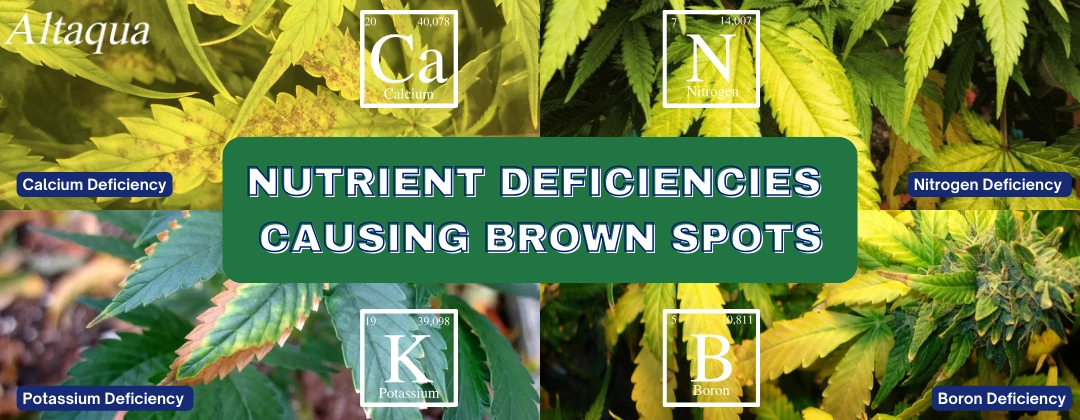
Pests, Diseases, and Brown Spots
No one likes uninvited guests, especially when they feast on your cannabis plants and invite diseases over for a meal. Little creatures and microscopic organisms can wreak havoc on your plants, often signaling their presence with brown spots.
Fungal Diseases like Septoria Leaf Spot
Septoria Leaf Spot, a fungal affliction, is a leading culprit behind brown spots on cannabis leaves. This fungus is far from selective; it targets not just cannabis but also other plants like tomatoes and soybeans. Its spores can linger in the soil, lying dormant until they find the right conditions to flourish. Then, they become airborne or attach themselves to insects and get splashed onto plants by rain or even your watering system. This condition is especially prevalent in outdoor gardens during late summer when the combination of warmth and moisture becomes a playground for this fungus.
Initially, the lower leaves of the cannabis plant get affected, showing small yellow spots. But don't let the benign appearance deceive you; these yellow spots soon turn into ugly brown splotches as the fungus multiplies. The infection then steadily marches upwards toward the newer leaves and even the developing flower. It’s not just an aesthetic issue; it can significantly diminish the health and yield of the plant.
Bacterial Issues such as Xanthomonas Leaf Spot
While less common than fungal diseases, bacterial leaf spots caused by pathogens like Xanthomonas can also result in brown spots on your cannabis plants. These bacteria are generally soil-borne but can also be spread through contaminated tools, water, and even wind-driven rain. Unlike fungal diseases that prefer warm, wet conditions, bacterial spots can occur in a variety of environments.
The spots may initially appear water-soaked and may become necrotic over time, surrounded by a yellow halo. As the disease advances, the spots can coalesce, leading to larger areas of dead tissue that can severely impede the plant's ability to photosynthesize effectively.
Environmental Stress and Brown Spots
The environment—the invisible hand that plays a significant role in the life of your cannabis plant. While it offers the essentials for growth, it can also be a source of stress. Brown spots, often the harbingers of doom, are among the visible manifestations of environmental stressors.
Low pH Levels
The acidity or alkalinity of the soil, known by its pH level, plays a more significant part than you might think in the well-being of your cannabis plant. For soil setups, the pH level—somewhere between 6.0 and 7.0—is where you want to aim for the most vibrant growth. For those employing hydroponic setups, aim for slightly more acidic, with pH levels between 5.5 and 6.5.
Straying from these optimal zones can lock out essential nutrients, making them unavailable to the plant. One of the visible signs of this nutrient lockout can be brown spots on the leaves, which resemble symptoms of nutrient deficiency but are actually due to the plant's inability to absorb the available nutrients because of improper pH levels.
Heat and Poor Air Circulation
Heat stress and subpar air circulation are subtle but sinister factors affecting your cannabis plant’s well-being. The damage may not be instantly noticeable, but the cumulative effects can be fatal for your plants. Poor air circulation can create pockets of stagnant air, causing humidity levels to rise and making it easier for mold and pests to settle in.
Excessive heat, especially temperatures above 80°F, can cause heat stress. The signs may start as wilting or curling leaves but can lead to brown spots as the plant cells get damaged by the elevated temperatures.
Overwatering or Underwatering
Believe it or not, water can be both a friend and a foe to your cannabis plant. Overwatering is often a beginner's mistake, where the eagerness to nourish leads to waterlogged soil. This can not only drown the roots but also create an environment where fungi like root rot can flourish. The first visible signs often appear on the leaves as dark brown spots.
On the other side of the spectrum, underwatering stresses the plant, weakening its defense systems. The lack of adequate moisture can disrupt cell integrity, leading to brown spots, particularly on the older leaves that are sacrificed as the plant focuses its limited resources on newer growth.
In all these scenarios, brown spots are like the distress signals sent out by your cannabis plant, a visual cue that something is wrong and needs immediate attention. Recognizing the underlying issues causing these spots is the first step toward effective treatment and prevention.
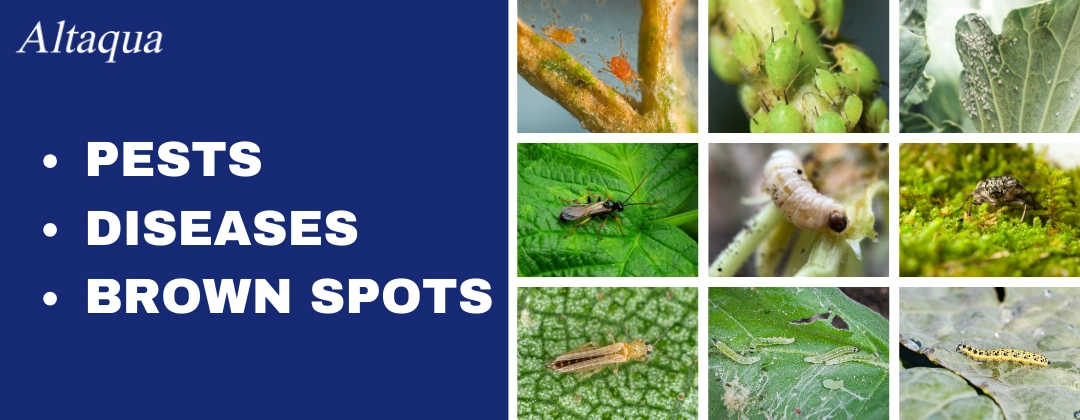
Identifying Types of Brown Spots and Their Causes
You've got a handle on the general culprits behind those worrisome brown spots on cannabis leaves. Now, let's get down to the nitty-gritty and pinpoint which kind of spots you're dealing with. Understanding their individual characteristics helps you address the root issues effectively. In the next section, we'll talk about diagnosing these spots for targeted treatment. But for now, let's focus on distinguishing among these not-so-welcome guests.
Rusty Spots
While tending to your cannabis garden, you notice some leaves showing rusty spots. This particular coloration usually indicates nutrient imbalances, especially involving calcium or magnesium deficiencies in the soil. The older leaves are usually the first to display these rusty hues, serving as a warning that they're not receiving the essential nutrients they need. Ignoring these signs could lead to this problem escalating from older to younger leaves, which can compromise the overall health and yield of the plant.
Burnt Tips
In cannabis cultivation, one common issue stems from over-fertilization, resulting in what's known as nutrient burn. This phenomenon manifests as burnt tips on the leaves, characterized by brown, crisped ends. Unlike the rusty spots, which are more about nutrient deficiencies, burnt tips indicate nutrient excess. Heeding this warning is crucial. Excessive nutrients not only damage the affected leaves but also put the plant at risk of decreased yield quality.
Circular Brown Spots
Finally, if you find leaves with brown, almost perfectly circular spots, you're likely dealing with a specific kind of fungal or bacterial issue. Diseases like Septoria leaf spot often present themselves this way, creating a series of brown circles that can spread across the leaf. While they may appear isolated initially, these spots can grow and coalesce if left untreated, leading to more extensive damage to the plant.
A deep dive into these specific types of brown spots equips you with the knowledge to tackle the underlying issues head-on. Each of these symptoms points to a distinct issue that needs addressing for optimal cannabis cultivation.
Diagnosing Brown Spot Issues on Cannabis
We're clued in on the different kinds of brown spots you might encounter on your cannabis plants. Knowing is half the battle, right? Now, it’s time to roll up those sleeves and dig in. What we need to do next is figure out what exactly is going on with your plants. We're moving from simply spotting the issue to diagnosing it for real. Once we pinpoint the problem, that sets us up to treat it in the most effective way.
Assessing Affected Plant Parts and Spot Patterns
First things first, get up close and personal with your cannabis plants. Examine them carefully from leaves to stems. Where are these spots showing up? Just the leaves? Or are they creeping down the stems, too? Different locations can mean different issues. Leaves are the usual suspects, but sometimes the issue runs deeper. For instance, if the roots appear brown and sludgy, root rot could be the culprit.
Also, the pattern matters. Take a closer look at the spots themselves. Are they more rusty, burnt, or circular? This will help you determine if it's a nutrient imbalance, over-fertilization, or a potential disease. Also, observe their spread pattern; isolated spots might indicate a less severe issue, while widespread discoloration could signify a more urgent problem.
Testing Growing Medium and Runoff Water
You can't ignore the environment your cannabis plant calls home. The quality of your growing medium affects your plant’s well-being. Depending on your setup—soil or hydroponic—you'll want to check the condition of the growing medium. In soil, you can get a simple testing kit to measure nutrient levels. In a hydroponic system, check the water's nutrient solution to ensure it's balanced. Imbalances here often translate to visible issues in the plant.
Examine the water that drains out from the bottom of your plant's container, known as runoff. Test its pH level and nutrient content. High acidity or alkalinity in the runoff can often clue you in on issues before they become visible on the plant.
Lab Testing for Accurate Diagnosis
Sometimes, home testing just won't cut it. You need the big guns for a clear answer. Sending a plant sample to a lab can give you precise information on nutrient deficiencies. This way, you're not just playing a guessing game but basing your next steps on scientific data.
Lab tests can be real game-changers. By analyzing plant tissue, labs can point out nutrient deficiencies or toxicities with a level of precision that home tests can't match. And if a disease is your suspect, specific lab tests can confirm the type of pathogens involved, helping you tailor your response more effectively.
When and How to Consult Experts
Maybe you've tried all the above, and the issue remains a mystery. Don't sweat it; even experienced growers seek expert advice. But who should you consult? Seek out pros with specialized knowledge in plant health, especially those familiar with cannabis. Prepare your questions and samples beforehand to make the most of the consultation.
With these diagnostic steps, you're well on your way to solving the mystery of those pesky brown spots. Up next, we'll discuss various treatment options to bring your cannabis plants back to their full glory.
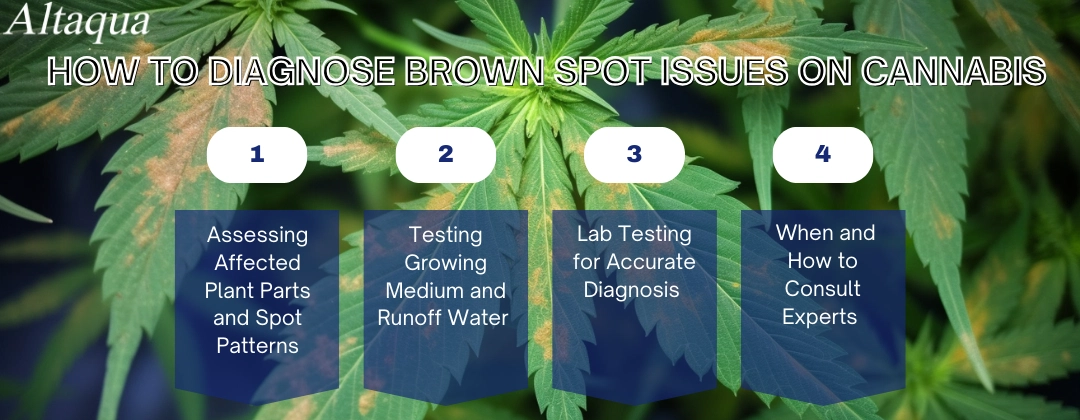
Effectively Treating and Preventing Brown Spots
You've gone full Sherlock on your cannabis plants and have an idea of what's causing those irksome brown spots. Knowing the problem is one thing; fixing it is another beast entirely. So, what are the tools and tactics you need to bring your green beauties back to health while preventing future outbreaks?
Addressing Underlying Nutrient Imbalances or Root Issues
First, let's talk about nutrients. If you've found out your cannabis plants are dealing with some sort of nutrient imbalance, this issue could be doing more than just creating brown spots; it could be holding back the full potential of your plants. The best approach starts by choosing supplements or fertilizers specifically designed to fix whatever nutrient your plant is lacking.
For example, if it's a calcium and magnesium deficiency, products like Cal-Mag can be a real game-changer. And don't just guess the dosage; always read the label carefully. Over time, continue to monitor the leaves for signs of improvement, but also keep tabs on the pH level of the soil to make sure you're not swinging from one problem into another.
Root problems are a bit more finicky. If you suspect something like root rot, you have to act fast. Begin by inspecting the roots, and if they're looking more like mushy spaghetti than strong tendrils, it’s time to get to work. You might need to trim away the diseased parts and then treat the remaining roots with an antifungal agent.
Sometimes, it's worth considering a complete soil change or a shift to a different growing medium altogether. Don't overlook the importance of oxygen for roots; a hydroponic oxygen system could make a world of difference for waterlogged plants.
Using Fungicides/Bactericides Against Infections
If your plants have a disease, kicking it to the curb means choosing the right weapon for the job. The fungicide or bactericide you pick can mean the difference between plant recovery and total crop failure. Read labels meticulously to find a product that’s effective against your specific issue and safe for cannabis plants. There's no one-size-fits-all here; while copper-based fungicides may work wonders for some, organic alternatives like neem oil could be a better fit for your setup.
Application is not just about slathering the product on the leaves and calling it a day. You need to think about timing and technique. The temperature matters; applying your chosen agent in the cool of the early morning or late evening minimizes stress on the plant. Additionally, wear gloves and take other safety precautions—because who wants a cure that causes a different kind of problem?
Adjusting Environmental Conditions
Now, if your growing environment is the culprit, we've got to talk about how you can fine-tune your conditions. Temperature and humidity are often at the top of the list. It’s not just about keeping things cool or dry; it’s about finding the right balance.
For precise control over temperature and humidity, nothing beats a specialized HVAC system. Take it from us at Altaqua; our HVAC systems are designed to give you that fine-tunes both temperature and humidity with a level of intelligence that sets it apart.
Our HVAC systems are like your personal climate butler. With Altaqua, you're outlining precise climate guidelines. Whether you desire a comfortable humidity level of 50-60% or temperatures that consistently hover between 70-80°F, once you've set the stage, Altaqua steals the show. But remember, it's not just technology we're offering; it's a perfectly orchestrated environment, where your plants can reach their ultimate potential.
Light and air circulation are also crucial. Too much direct light can fry your plants faster than you can say "sunburn." If your plants are too close to the light source, consider raising it or using reflectors to disperse the intensity. A well-placed oscillating fan can do wonders for air circulation, helping to keep those leaves dry and less susceptible to fungal growth.
Pest Control Solutions
Pests are the uninvited guests at your cannabis garden party. From aphids to spider mites, these little critters can wreak havoc. The trick is to not go nuclear at the first sign of an invader. Natural solutions like introducing predatory insects—think ladybugs—can be an effective first step. However, for more severe infestations, chemical pesticides might be necessary. Just be careful and read the label to ensure it's suitable for cannabis plants.
It's not just about reactive measures, though. Proactivity goes a long way in pest control. Regular inspections of your plants can catch an infestation early on. Additionally, traps and camera monitoring can help you gauge the effectiveness of your methods over time. Being consistent in monitoring can save you a lot of headaches down the line.
Treating and preventing brown spots on your cannabis plants is no small feat. It’s a multifaceted approach involving nutrients, roots, potential diseases, environmental controls, and yes, even pest management. But as you take control, solutions like Altaqua’s HVAC systems can serve as powerful tools in your arsenal. With all these pieces in place, you're not just solving the immediate issue but are setting the stage for a long-term, thriving grow operation. Keep nurturing your plants, and they'll do their part to keep those brown spots at bay.
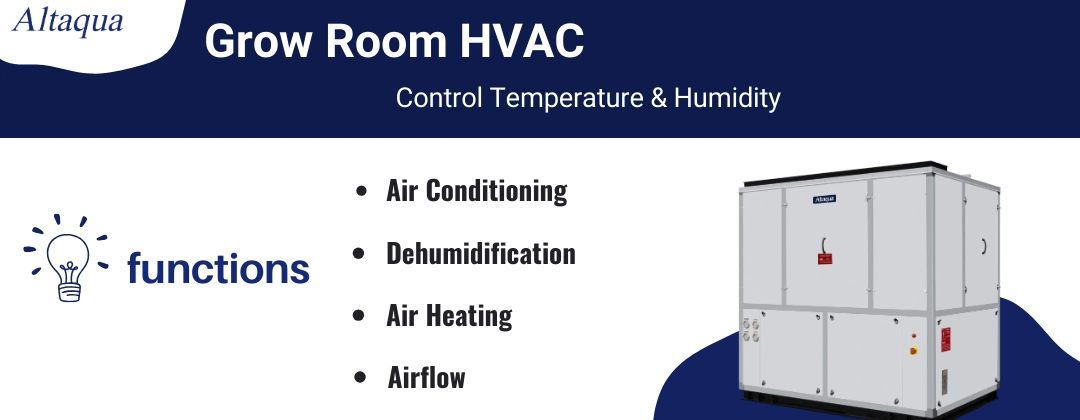
Final Thoughts on Managing Brown Spots on Weed Leaves
From the moment you notice those puzzling brown spots on your cannabis plants to rolling up your sleeves and getting into the nitty-gritty of diagnosis, you're never alone in this journey. Armed with the proper knowledge and tools, it's easier than you think to reclaim your cannabis plants' vibrant health.
First, identifying the core issues, whether nutrient imbalances or root troubles, is half the battle won. With the right supplements and root management, you can address these problems head-on. Proper fungicides or bactericides can save the day when pathogens are the culprits.
And let's remember your grow room's climate. With advanced solutions like Altaqua's HVAC systems, you're not just controlling the environment but setting the stage for plant growth on your terms—precise, reliable, and downright practical.
Last, even the best of us face unexpected challenges, like pesky pests. In those moments, having a game plan for pest control can make all the difference.
FAQ
1. Why are there brown spots on my weed leaves?
Brown spots on your cannabis leaves can pop up for many reasons, from issues with nutrients and roots to nasty bugs and mold. Figuring out what's going wrong is your first step in nipping this issue in the bud and keeping it from returning.
2. How do I treat brown spots on cannabis leaves?
The first step is identifying the underlying cause, whether nutrient imbalances or root issues. For nutrient problems, consider nutritional supplements and fertilizers. If root issues are the culprit, root management and repair are key. Fungicides or bactericides can help with infections, while environmental adjustments like temperature and humidity control can also make a difference.
3. Can brown spots spread to other leaves?
Yes, brown spots can spread if caused by fungal or bacterial infections. Immediate treatment is essential. The proper fungicides or bactericides and application methods will help curtail the spread.
4. Are chemical treatments for brown spots on weed leaves safe?
Chemical treatments like fungicides and bactericides are generally safe if used according to the manufacturer's instructions. However, always take precautions to minimize risks, including wearing protective gear and avoiding overspray.
5. How can I monitor and prevent brown spots in the future?
Constant vigilance is critical. Regularly check leaves for any early signs of browning or spotting. Implement preventive measures like environmental controls for temperature and humidity and employ a regular schedule of natural or chemical pest control solutions.
Share with your friends:
Popular Blogs on Altaqua:
Download Catalogue
